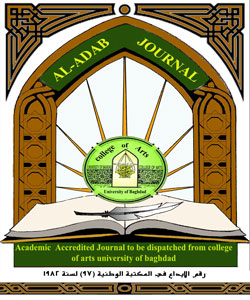The Social marginalization and its relationship with the Subversive personality
DOI:
https://doi.org/10.31973/aj.v0i133.900Keywords:
Social marginalization, subversive personalityAbstract
The research aims
Measure .the Social marginalization and the destructiveness personality. To
Defining the differences in the Social margianalization and destructiveness personality according to gendar (males & females ) besides to identifying the correlation between Social margianalization and destructiveness personality,
In order to accomplish thr researchs aims, the researcher adoption Al-Shammari.2013 scale which consisted of (28) paragraphs to destructiveness personality , and Gallie scale ,2002 which was translated by Al-Janabi,2014 which consisting of (19) paragraphs Social marginalization acheived the validity and the ability and psychometric devices, the two Measures where applied to sample amounted to (200) students "males & females"The data where statistically processed , and the results concluded that evening studies
Students they suffer from the. Social marginalization and destructiveness personality-and There are differences in the destructiveness personality between males and females and in favor of males,while there are no differences in the Social marginalization .Moreover, there is a correlation between the Social marginalization and subversive personality. In light of the results, the researcher set of recomendations and suggestions.
Downloads
References
• Coser, Rosenberg (1965), Sociological Theory, The Macmillan Company, N.Y.
• Field, S., Kuczera, M. and Pont, B. (2007). No More Failures: Ten Steps to Equity in Education, Paris, OECD.
• Ebel , R,L, (1972) : Essentials of Educational Measurement. New Jersey prentice – Hall , Inc.
• Ellis , A, & (1977) : Rational Emotive therapy , Research Hypotheses of (R.E.T) , and other Modal of Cognitive Behavior. Therapy THE, Counseling psychologist Vol. , No (7) (1) , pp. (3-42).
• Fromm, E, (1973) : The anatomy of human destructives , New York : Holt Rinehart and Winston.
• Flanagan , J& Flanagan .R. (2004) : Counseling and psychotherapy theories in context and practice (Skills – Strategies – Techniques ) . John Wiley & Sons Ine.
• Gallie, D. (2002) Social Precarity and Social Integration. European Commission, Directorate General, Eurobarometer 56.1. Brussels.
• Hollin , C, R,(1989) : " Psychology and Crime , An Introduction to Criminological psychology : First Edition , Routledge press Inc , Bechenham , U, K.
• Kassin , Saul , (2001) : Psychology , New Jersey : Prentice Hall, third Edition.
• Keniston, K. (1965), The Uncommitted Alienated Youth in American Society, N.Y., PP.13-15.
• Nunnally, J . G, (1978): Psychometric theory, 2nd, Edition, New York, Mc Graw – hill.
• Schneidmn, E.S. & Farberow , N, L , (1975) : Clues to Suicide , First Edition , McGraw – Hill Book Company, New York, U.SA.
• Sutton , Jan &Martinson , Deb,(2003) : Because I Hurt : understanding Self – Injury and Healing The Hurt , How to books, U.K.
• Tajfel, H. Tarner, J.C. (1986), The Social Identity Theory of Intergroup Behavior. In S. Worchel and W.G. Austin. (Eds.), Psychology of intergroup relations, (2nd) Chicago, IL. Nelson-Hall Publisher.
• Wrightsman , L, Deaux, (1981) : Social psychology in the 80s , California. Cole & Company.
Downloads
Published
Issue
Section
License
Copyright and Licensing:
For all articles published in Al-Adab journal, copyright is retained by the authors. Articles are licensed under an open access Creative Commons CC BY 4.0 license, meaning that anyone may download and read the paper for free. In addition, the article may be reused and quoted provided that the original published version is cited. These conditions allow for maximum use and exposure of the work.
Reproducing Published Material from other Publishers: It is absolutely essential that authors obtain permission to reproduce any published material (figures, schemes, tables or any extract of a text) which does not fall into the public domain, or for which they do not hold the copyright. Permission should be requested by the authors from the copyrightholder (usually the Publisher, please refer to the imprint of the individual publications to identify the copyrightholder).
Permission is required for: Your own works published by other Publishers and for which you did not retain copyright.
Substantial extracts from anyones' works or a series of works.
Use of Tables, Graphs, Charts, Schemes and Artworks if they are unaltered or slightly modified.
Photographs for which you do not hold copyright.
Permission is not required for: Reconstruction of your own table with data already published elsewhere. Please notice that in this case you must cite the source of the data in the form of either "Data from..." or "Adapted from...".
Reasonably short quotes are considered fair use and therefore do not require permission.
Graphs, Charts, Schemes and Artworks that are completely redrawn by the authors and significantly changed beyond recognition do not require permission.
Obtaining Permission
In order to avoid unnecessary delays in the publication process, you should start obtaining permissions as early as possible. If in any doubt about the copyright, apply for permission. Al-Adab Journal cannot publish material from other publications without permission.
The copyright holder may give you instructions on the form of acknowledgement to be followed; otherwise follow the style: "Reproduced with permission from [author], [book/journal title]; published by [publisher], [year].' at the end of the caption of the Table, Figure or Scheme.











